Last meeting in 2006:

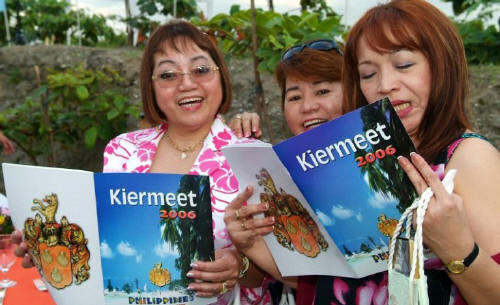
Filipino Serenas
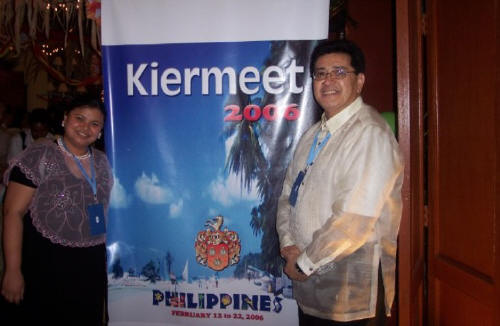
Casey & Louie Kierulf
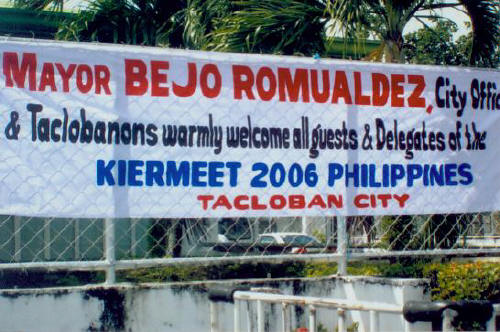
Warm welcome in Tacloban
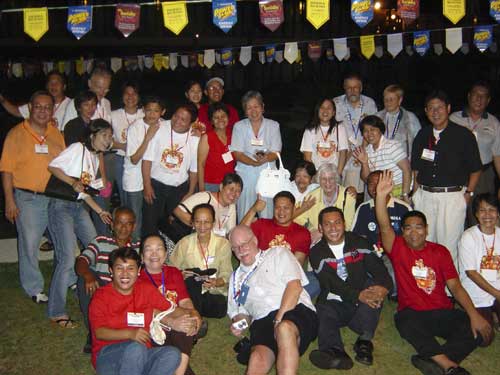
Party in Ormoc
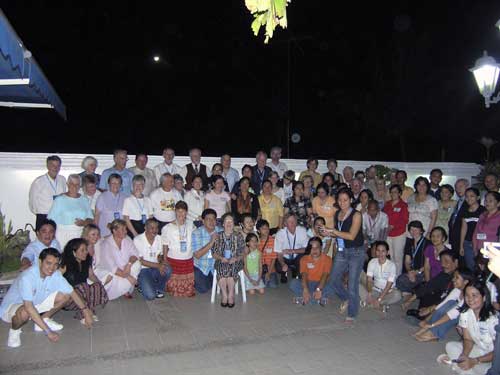
Party in Cebu
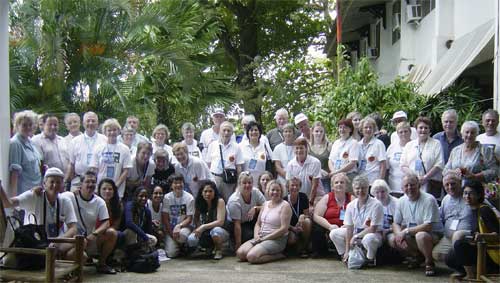
Some Kiermeet participants
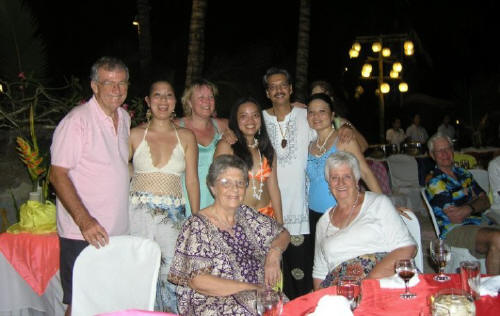
Partying on the beach
(Boracay)
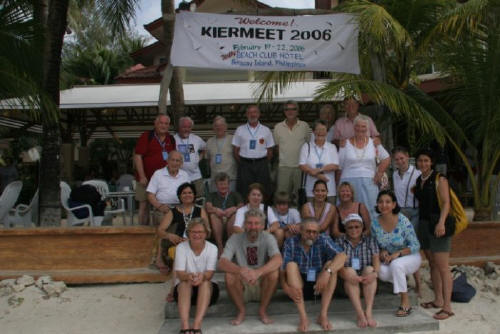
Boracay - beach resort
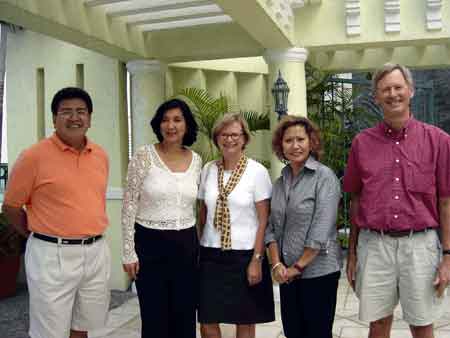
Some Philippine & Danish
committee members met Jan 2004 in Manila
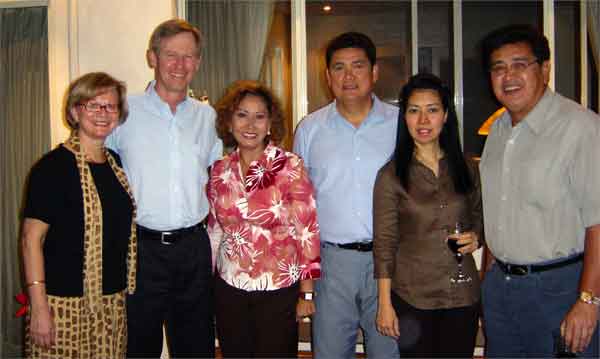
The Philippines

Fact about the
Philippines
Article from ENCYCLOP∆DIA
BRITANNICA
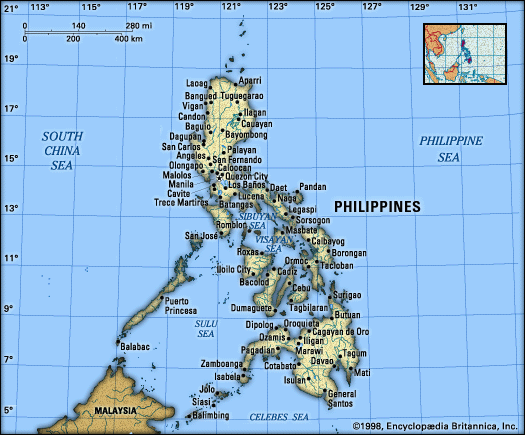
Location:
Off the southeast coast of Asia, lying between
Taiwan
in the north and Borneo in the South. The Western Pacific Ocean and the South
China Sea border its eastern and western limits, respectively.
Population
84,525,639 (July 2002 est.)
Time Zone:
GMT plus 8
hours
What to Wear:
Light, casual clothes are recommended. Warmer garments are needed for mountain
regions. When visiting churches and temples, propriety dictates that shorts and
scanty clothing be avoided. Formal occasions require dinner jackets and ties (or
the Philippine barong Tagalog) for men and cocktail or long gowns for women.
Currency:
Unit of currency: Pesos (P) = 100 centavos. bank notes:
P10,P20,P50,P100,P500,P1000. Coins: 5c,10c,25c, P1,P5,P10.
Tipping:
Tipping is expected for many services. the standard practice is 10 % of the
total bill. Tipping is optional on bills that already include 10% service
charge.
Language:
Filipino is the national language. English is the business language and spoken
widely.
Accommodation:
In Metro Manila, key cities and towns throughout the country, a wide selection
of de luxe, standard, economy and pension type accommodations is available. In
island destinations, there is a variety of resorts ranging from de luxe to
special interest category.
Dining Out:
Filipino food is an exotic, tasteful blend of Oriental, European, and American
culinary influences. There is a wide variety of fresh seafood and detectable
fruits. first class restaurant offer gourment specialties as well as Filipino
cuisine.
Entertainment and Culture:
Metro Manila is the center of entertainment and cultural activities. The premier
venue for the performing arts, the Cultural Center of the Philippines, features
world-class performances by local and international guest artist. Museums
located in Manila and in some parts of the country offer glimpse of Philippine
history and culture. Art galleries exhibit the works of the country's leading
and promising visual artist.
Manila nightlife is one of the vibrant in Asia, reflecting the Filipinos love
for music. The hubs of nightlife are the Remedious Circle in Malate, Ayala
Center and the Fort at Bonifacio Global City in Makati, Timog and Tomas Morato
Avenues in Quezon City, and Eastwood in Libis, Quezon City. Nightclubs, music
lounges,pubs, and sing-along bars feature Filipino bands and singers who are
known for their great musical talent. De luxe hotels offer a variety of live
musical entertainment, concerts and stage plays form part of the country's
entertainment.
For visitors who want to try their luck at the gaming tables there are casinos
in Metro Manila and in the cities of Angeles, Olongapo, Tagaytay, Cebu, Davao,
Bacolod, and Laoag.
Shopping:
Visitors can choose from an exciting selection of great buys in a country known
for export-quality items at reasonable prices: South Sea pearls, hand woven
clothes, terra cota, porcelain, coral and mother of pearl home accessories.
Artifacts, pineapple fiber shirts, prehistoric jars, native handicrafts, and
footwear are interesting items too. The Philippines also produces fine basketry,
furniture, fresh and processed fruits, exquisitely crafted jewellry, and gift
items made of shell, wood and stone.
Big malls are located in Manila, Makati and EDSA, while handicraft, antique and
curio shops abound at the Ermita District in Manila.
Business and Banking Hours:
Private and
government offices are open either from 8:00 a.m. to 5:00 p.m. or from 9:00 a.m.
to 6:00 p.m. Some private companies hold office on Saturdays from 9:00 a.m. to
12:00 noon. Most shopping malls, department stores, and supermarkets are open
from 10:00 a.m. to 8:00 p.m. daily. There are 24-hour convenience stores and
drugstores.
Banks are open from 9:00 a.m. to 3:00 p.m., Mondays to Fridays, with automated
teller machines (ATM) operating 24 hours.
Credit Cards:
International credit cards such as Visa, Diners Club, Mastercard, and American
Express Card are accepted in major establishments.
Electricity:
220 volts,
A.C. 60 cyles. Most hotels have 110-volts outlets.
Water:
Water
in Metro
Manila and in key cities and towns is potable and safe for drinking. Bottled
water is available in many hotels, restaurants, resorts, supermarkets, and
convenience stores.
Communication Facilities:
The country
has international and national direct dial phone and facsimile service, mobile
phone sites, internet and e-mail facilities, and worldwide express delivery
service. The postal system is efficient.
Most national dailies are in English. Foreign publications are sold at major
hotels, malls, and bookstores in Metro Manila and key cities. There are 7
national television stations which broadcast mainly in Filipino. Cable TV is
available in many hotels in Manila and in many parts of the country.
Medical Services:
Hospitals in
the country are equipped with modern facilities to meet any medical need. In
some remote towns and cities, clinics and health centers provide emergency
medical attention. Most hotels and resorts provide medical assistance. Hospitals
are listed in the "Yellow Pages" of the local telephone directory.
This
is what ENCYCLOP∆DIA BRITANNICA says about the Philippines:
Officially
REPUBLIC OF THE PHILIPPINES,
Pilipino
REPUBLIKA —G PILIPINAS, country in Southeast Asia. It is an archipelago
consisting of some 7,100 islands and islets lying about 500 miles off the coast.
The total land area of
the Philippines is 115,800 square miles (300,000 square kilometres).
It is bounded by the Philippine Sea to the east, the Celebes Sea to the south,
and the South China Sea to the west and north.
The Philippines takes its name from Philip II, who was king of Spain during the
Spanish colonization of the islands in the 16th century. Manila is the biggest
city and the national capital. It is located on Luzon, the largest island, which
has a land area of 40,420 square miles. Mindanao, at 36,537 square miles the
second largest island, lies in the south.
The archipelago spreads out in
the form of a triangle, with the islands south of Palawan, the Sulu Archipelago,
and the island of Mindanao forming (west-east) its southern base and the Batan
Islands, in the north, its apex. The islands
stretch for about 1,150 miles (1,850 kilometres) from north to south and for
about 700 miles from east to west at their widest extent. Only about two-fifths
of the islands and islets have names, and only some 350 have areas of one square
mile or more. The large islands fall into three groups: (1) the Luzon group in
the north and west, consisting of Luzon, Mindoro,
and Palawan; (2) the Visayan group in the centre, consisting of Bohol, Cebu,
Leyte, Masbate, Negros, Panay, and Samar; and (3) Mindanao in the south.
Because it was under Spanish rule
for 333 years and under U.S. tutelage for a further 48 years, the Philippines
has many cultural affinities with the West. It is, for example, the fourth most
populous country in which English is an official language and the only
predominantly Roman Catholic country in Southeast Asia. Its peoples, however,
are Asian in consciousness and in aspiration. In many ways Filipino society is
composed of paradoxes, perhaps the most apparent being the great extremes of
wealth and poverty in the nation. The Philippines is a country of rich resources,
but it is in the process of developing its full potentialities. It is primarily
agricultural, although a high degree of domestic and foreign investment has
spurred the rapid development of its industrial potential. Educationally, it is
among the most advanced of Asian countries, having a high literacy rate.
![]()










